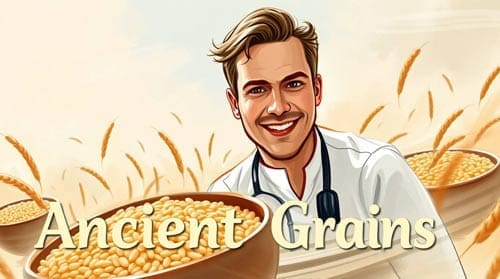Ancient Grains: A Comprehensive Overview for Healthcare Professionals
Please like and subscribe if you enjoyed this video 🙂
Video Overview
This video provides a thorough examination of ancient grains, including their history, types, and nutritional information. It focuses on various ancient grain varieties such as Amaranth, Millet, Kamut, Sorghum, Teff, Freekeh, Farro, Barley, Quinoa, Fonio, and Spelt. The study highlights the nutritional benefits of these grains, particularly their fiber content and other essential nutrients. This review aims to equip healthcare professionals with valuable knowledge about ancient grains and their potential role in promoting health and nutrition.
Introduction
Ancient grains have gained considerable attention in recent years due to their nutritional value and potential health benefits. These grains have been cultivated for thousands of years and have remained largely unchanged over time. This video aims to define ancient grains, explore their history, and provide detailed information about various types and their nutritional profiles.

Defining Ancient Grains
Ancient grains are typically defined as grains that have remained largely unchanged over the last several hundred years. Unlike modern wheat, which has been selectively bred for higher yields and easier processing, ancient grains retain their original genetic structure. This often results in a more diverse nutritional profile and potential health benefits.
History of Ancient Grains
The cultivation of grains dates back to the dawn of agriculture, approximately 10,000 years ago. Many ancient grains were staple foods in various cultures around the world. For example, quinoa was a sacred crop for the Incas, while millet was widely consumed in ancient China. These grains played crucial roles in the development of human civilization and continue to be important in many traditional diets today.
Types of Ancient Grains
Amaranth
Amaranth is a small, gluten-free grain that was a staple food of the Aztecs. It is rich in protein, containing all nine essential amino acids. Amaranth is also high in fiber, iron, and calcium. One cup of cooked amaranth contains 9 grams of protein, 5 grams of fiber, 91 percent of daily requirements for manganese, 38 percent for magnesium and 29 percent for iron.
Millet
Millet is a small-seeded grass that has been cultivated for thousands of years in Africa and Asia. It is gluten-free and rich in antioxidants, magnesium, and phosphorus. Millet contains a variety of nutrients linked to lower inflammation, reduced heart disease risk, and improved blood sugar control. For example, a study in 105 people with type 2 diabetes found that replacing rice with millet in a meal reduced post-meal blood sugar levels by 27%. Millet is versatile and gluten-free. It can be enjoyed as a hot breakfast cereal or in place of other grains like rice, couscous, and quinoa. One cup of cooked millet contains 6 grams of protein, and 2 grams of fiber.
Kamut
Kamut, also known as Khorasan wheat, is an ancient variety of wheat. It has a rich, buttery flavor and contains more protein than modern wheat. Kamut is also high in selenium and zinc. One cup of cooked kamut contains 10 grams of protein, and 7 grams of fiber. It has 100 percent daily value of selenium, 29 percent zinc and 25 percent of niacin.
Sorghum
Sorghum is a gluten-free grain that originated in Africa. It is rich in antioxidants and provides a good source of fiber, protein, and minerals such as iron and phosphorus. It also has higher amounts of resistant starch. Sorghum is not only high in nutrients but also but also a good source of powerful polyphenol plant compounds, including anthocyanins and phenolic acids, which function as antioxidants inside your body. One cup of cooked sorghum contains 11 grams of protein, and 7 grams of fiber.
Teff
Teff is a tiny grain native to Ethiopia. It is gluten-free and rich in calcium, iron, copper, manganese, vitamin C and protein. Teff is also a good source of resistant starch, which may benefit gut health. Although teff grains are tiny, they’re packed with important nutrients, such as iron and magnesium. They are also one of the few grains that boast vitamin C, a nutrient vital for immune and bone health. One cup of cooked teff contains 13.3 grams of protein, and 8 grams of fiber.
Freekeh
Freekeh is a form of wheat that is harvested while still green and then roasted. It has a smoky flavor and is high in fiber and protein. In particular, freekeh is a good source of the carotenoids lutein and zeaxanthin. A higher intake of these compounds has been linked to a lower risk of degenerative eye disorders, such as cataracts and age-related macular degeneration. As freekeh contains gluten, people with celiac disease and other gluten-related conditions should avoid it. Freekeh has an earthy, nutty taste, with a chewy texture like that of brown rice. As a versatile grain, it makes an excellent addition to soups, stews, casseroles, and summer salads. One cup of cooked freekeh contains 20 grams of protein, and 10 grams of fiber.
Farro
Farro is an ancient wheat grain that has been cultivated in Italy for centuries. It is rich in fiber, protein, and various vitamins and minerals, including magnesium and zinc. Farro is high in antioxidants like polyphenols, carotenoids, and phytosterols, which may lower your risk of several chronic illnesses, such as heart disease and certain cancers. Additionally, farro is particularly high in protein and fiber, which may help maintain a healthy body weight by curbing your appetite and keeping you full after meals. This gluten-containing grain is easy to include in your diet and can be eaten much like other grains. You can add it to dishes like salads and soups. One cup of cooked farro contains 13 grams of protein, and 11 grams of fiber.
Barley
Barley is one of the oldest cultivated grains in the world. It is high in fiber, particularly beta-glucan, which has been shown to help lower cholesterol. Barley is also a good source of selenium and manganese. Barley is affordable, widely available, and easy to eat. However, it is not gluten-free. One cup of cooked barley contains 4 grams of protein, and 6 grams of fiber.
Quinoa
Quinoa is a seed that is prepared and eaten like a grain. It is gluten-free and contains all nine essential amino acids, making it a complete protein. Quinoa is also rich in fiber, iron, and magnesium. Quinoa contains potent antioxidants, such as quercetin and kaempferol, which have been shown to have anti-inflammatory and anticancer properties in animal studies. What’s more, this grain is an excellent source of plant-based protein, boasting 8 grams per 1-cup (185-gram) serving. Protein is the most filling macronutrient, and adding more protein-rich foods to your diet may help regulate hunger and promote weight loss. Due to its popularity, quinoa is widely available in supermarkets and health food stores. It has a mild taste and is easy to incorporate into breakfast bowls, lunches, and dinners.
Fonio
Fonio is a small grain native to West Africa. It is gluten-free and rich in amino acids. Fonio is also a good source of iron, calcium, and phosphorus. Fonio also boasts good amounts of magnesium, copper, and zinc. It may contain resistant starch, which passes through your digestive tract without being broken down and feeds your healthy gut bacteria. Fonio is not widely available in the United States but can be purchased online. It can be ground to make a delicious gluten-free flour for baking or cooked for a fluffy, couscous-like texture. One cup of cooked fonio contains 4 grams of protein, and 2 grams of fiber.
Spelt
Spelt is an ancient variety of wheat with a nutty flavor. It is higher in protein than modern wheat and contains various vitamins and minerals, including manganese and copper.

Nutritional Information
Ancient grains are generally rich in nutrients, offering a variety of health benefits. Here’s a more detailed look at their nutritional profiles:
Fiber Content
Most ancient grains are excellent sources of dietary fiber. For example:
Barley contains about 17 grams of fiber per 100 grams.
Farro provides about 9 grams of fiber per 100 grams.
Quinoa contains about 7 grams of fiber per 100 grams.
High fiber intake is associated with improved digestive health, lower cholesterol levels, and better blood sugar control.
Protein Content
Many ancient grains are good sources of protein:
Quinoa contains about 14 grams of protein per 100 grams.
Amaranth provides about 13 grams of protein per 100 grams.
Kamut contains about 15 grams of protein per 100 grams.
Protein is essential for building and repairing tissues, making enzymes and hormones, and supporting immune function.
Vitamins and Minerals
Ancient grains are rich in various vitamins and minerals:
Iron: Teff and amaranth are particularly high in iron, which is essential for oxygen transport in the blood.
Magnesium: Quinoa and millet are good sources of magnesium, important for bone health and energy production.
B vitamins: Many ancient grains, including barley and spelt, are rich in B vitamins, which play crucial roles in energy metabolism.
Antioxidants
Several ancient grains are rich in antioxidants, which help protect cells from damage:
Sorghum is high in various antioxidants, including phenolic compounds and anthocyanins.
Quinoa contains quercetin and kaempferol, powerful plant antioxidants with anti-inflammatory effects.

Health Benefits of Ancient Grains
The nutrient profiles of ancient grains suggest several potential health benefits:
1. Cardiovascular Health Impact– Research shows that ancient grains play a considerable role in heart health maintenance. A randomized crossover trial involving 45 healthy adults found that consuming ancient grain bread for 8 weeks led to significant reductions in both total cholesterol and LDL cholesterol. The study also revealed an increase in endothelial progenitor cells, which help repair blood vessels. People who consumed at least three servings of whole grains daily experienced smaller increases in blood pressure compared to those eating less than half a serving per day [14]. A Harvard study demonstrated that individuals consuming 70 grams of whole grains daily had a 23% lower risk of cardiovascular disease mortality [11].
2. Blood Sugar Management– Ancient grains demonstrate remarkable effects on blood glucose control. Key findings include the following. Barley’s high β-glucan content helps control blood glucose and insulin resistance. Ancient wheat varieties produce smaller rises in blood sugar due to their fiber content. Whole grain consumption is associated with improved insulin sensitivity. The beneficial effects are particularly notable in type 2 diabetes management. Studies indicate that ancient grains’ soluble fiber content helps slow gastric emptying, which decreases post-meal blood glucose spikes. This mechanism is enhanced when ancient grains are consumed with healthy fats or lean proteins.
3. Digestive System Benefits – Ancient grains contribute significantly to digestive health through their unique fiber composition. A comprehensive analysis revealed that their fiber content aids in the following. Promoting healthy gut bacteria growth. Supporting regular bowel movements. Enhancing nutrient absorption.
The soluble fiber in ancient grains plays a crucial role in supporting a healthy microbiome, which has demonstrated positive effects on the immune system and anti-inflammatory responses. Research indicates that ancient grains’ fiber composition may be more effective at alleviating digestive issues compared to modern grain varieties. Some ancient grains are also gluten-free. So if you have a gluten intolerance or celiac disease, you can consider the following as alternatives to grains with gluten: Quinoa, Amaranth, Buckwheat, Millet, Sorghum and Teff.
4. Weight Management. The high protein and fiber content of many ancient grains can promote feelings of fullness, potentially aiding in weight management.
5. Gluten-Free Options: Several ancient grains (like quinoa, amaranth, and millet) are naturally gluten-free, making them suitable for people with celiac disease or gluten sensitivity.
Incorporating Ancient Grains into the Diet
Healthcare professionals can encourage patients to incorporate ancient grains into their diets in various ways:
1. Substitution: Ancient grains can often be used in place of rice or pasta in many dishes.
2. Breakfast Options: Ancient grains can be used to make hot cereals or added to yogurt or smoothies.
3. Baking: Many ancient grains can be ground into flour for use in baking bread, muffins, or other baked goods.
4. Side Dishes: Cooked ancient grains make excellent side dishes, either on their own or mixed with vegetables.
Challenges and Considerations
While ancient grains offer many benefits, there are some challenges to consider:
1. Availability: Some ancient grains may not be as readily available as more common grains.
2. Cost: Ancient grains can be more expensive than conventional grains.
3. Cooking Time: Some ancient grains require longer cooking times than more processed grains.
4. Allergies: While many ancient grains are gluten-free, individuals with celiac disease or gluten sensitivity should still check labels carefully.


Conclusion
Ancient grains offer a wealth of nutritional benefits and can be a valuable addition to a healthy diet. Their high content of fiber, protein, vitamins, and minerals makes them an excellent choice for improving overall nutrition. Healthcare professionals can play a crucial role in educating patients about the benefits of ancient grains and providing guidance on how to incorporate them into daily meals.
As research continues, we may discover even more about the potential health benefits of these time-honored grains. Encouraging the consumption of a variety of ancient grains can contribute to a more diverse and nutritious diet, potentially leading to improved health outcomes for patients.
Frequently Asked Questions:
Question 1. What are ancient grains and why are they important?
Ancient grains are cereal and pseudocereal varieties that have remained largely unchanged for thousands of years. They are important due to their superior nutritional profiles, containing higher levels of proteins, minerals, and antioxidants compared to modern grains. These grains also play a crucial role in sustainable agriculture and global food security.
Question 2. How do ancient grains benefit heart health?
Ancient grains have been shown to significantly improve cardiovascular health. Studies indicate that regular consumption of ancient grains can lead to reductions in total and LDL cholesterol levels. Additionally, people who consume whole grains daily have a lower risk of cardiovascular disease mortality compared to those who eat less.
Question 3. Can ancient grains help manage blood sugar levels?
Yes, ancient grains are beneficial for blood sugar management. Their high fiber content slows down digestion and helps control blood glucose spikes. Ancient wheat varieties, in particular, produce smaller rises in blood sugar compared to modern wheat. This makes ancient grains especially valuable for individuals managing type 2 diabetes.
Question 4. How do processing methods affect the nutritional value of ancient grains?
Processing methods significantly impact the nutrient retention in ancient grains. Traditional methods like stone milling tend to preserve more nutrients compared to modern roller milling. Cooking methods such as boiling and steaming retain most nutrients, while excessive milling can result in substantial losses of minerals like iron and zinc.
Question 5. What role do ancient grains play in sustainable agriculture?
Ancient grains are crucial for sustainable agriculture due to their environmental efficiency and climate resilience. They require less water compared to common crops like rice and wheat, and can thrive in harsh conditions with minimal pesticide and fertilizer inputs. Their ability to adapt to challenging environments makes them valuable for climate-smart agriculture and global food security.

